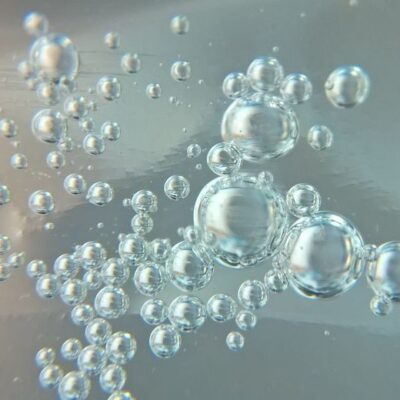Function3,4,5
Hydrogen peroxide serves several purposes in the food industry, such as:
- Oxidizing and reducing agent: mainly for stabilizing eggs, egg whites and egg yolks via reacting with catalase enzyme.
- Bleaching agent: by improving the color of food products such as flour, edible oil, egg white, among others.
- Dough conditioner: via oxidizing sulfhydryl groups and forming disulfide bridges increasing, increasing the strength of the gluten network.
- Removal of sulfur dioxide: mainly in wine, corn syrup and starch.
- Increasing water binding: by increasing water absorption, reducing dough stickiness and stabilizing gluten network.
Commercial production1
Production of hydrogen peroxide follows the anthraquinone process, as described below:
- Hydrogenation of 2-ethyl anthraquinone (EAQ) to 2-ethyl anthrahydroquinone (EAHQ) in a reactor using hydrogen gas and a catalyst.
- Oxidation of EAHQ using oxygen from the air to produce H2O2.
- Purification: using a resin bed to remove organic compounds.
- Concentration to 70% (w/w) v in a vacuum distillation column.
- Recovery using a dryer to adjust water content followed by recycling back to the hydrogenation reactor.
Application3,6
- Stabilizer and oxidizing agent for egg products such as egg whites and egg yolks
- Flour bleaching agent
- Color improver for edible oils
- Gluten network stabilizer and dough conditioner as well as water absorption capacity enhancer
- Elimination of sulfur dioxide in several food products such as wine, starch and corn syrup
Summary of hydrogen peroxide applications and dosage limits in foods as established by the FDA:4
| Food | Maximum dose | Use |
| Dried eggs, dried egg white, and dried egg yolks | 10% | Oxidizing and reducing agent |
| Corn syrup | 0.15% | Reduction sulfur dioxide levels |
| Wine vinegar | Amount sufficient for the purpose | Removal of sulfur dioxide |
| Emulsifiers containing fatty acids esters | 1.25% | Bleaching agent |
FDA regulations
Hydrogen peroxide is generally recognized as safe by the Food and Drug Administration (FDA).6
References
- Intratec. Hydrogen Peroxide Production Process – Cost Analysis – H2O2 E11A. Intratec Solutions LLC, 2019, pp. 8-9, https://books.google.co.ve/books?id=aEuwDwAAQBAJ&printsec=frontcover&dq=hydrogen+peroxide&hl=es-419&sa=X&ved=0ahUKEwjuzfbIjsbpAhXQdN8KHclZAaMQ6AEIJjAA#v=onepage&q=hydrogen%20peroxide&f=false . Accessed 21 May 2020.
- Abdollahi, M., and A. Hosseini. “Hydrogen peroxide.” Reference Module in Biomedical Sciences, from Encyclopedia of Toxicology (2014): 967-970.
- Stanga, Mario. Sanitation: cleaning and disinfection in the food industry. John Wiley & Sons, 2010.
- Stadelman, William J., Debbie Newkirk, and Lynne Newby. Egg science and technology. CRC Press, 2017.
- Cauvain, S. P. Breadmaking: improving quality. Elsevier, 2012, p. 487.
- U.S. Department of Health and Human Services.” Direct Food Substances Affirmed As Generally Recognized As Safe”.Title 21 Code of Federal Regulation, pt. 184. September 2019. Available at https://www.accessdata.fda.gov/scripts/cdrh/cfdocs/cfCFR/CFRSearch.cfm?fr=184.1366&SearchTerm=hydrogen%20peroxide. Accessed 21 May 2020.

